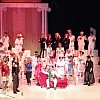Orphée aux Enfers, Jacques Offenbach
| Oorspronkelijke titel | Orphée aux Enfers |
| Nederlandse titel | Orpheus in de Onderwereld |
| Componist | Jacques Offenbach |
| Tekstdichter | Hector Crémieux en Ludovic Halévy |
| Vertaling | Joop C.G. Fransen |
| Genre | Opéra-bouffon (komische opera) in vier bedrijven |
| Première | 21 oktober 1858, Théâtre des Bouffes-Parisiens, Parijs |
| Tijd van handeling | Het stuk speelt in de Griekse Oudheid |
| Plaats van handeling |
|
| Belangrijkste rollen |
|
| Kooraandeel | Veel koor |
| Orkestbezetting | 2 fluiten, 2 hobo's, 2 klarinetten, 2 fagotten, 2 hoorns, 2 trompetten, 3 trombones, pauken/slagwerk, strijkers |
| Bijzondere eisen |
Eurydice moet liefst een coloratuursopraan zijn. Pluto, de tenor, heeft een aria met falsetnoten (maar die zijn niet verplicht). In de finale van het tweede bedrijf kan een fanfare-orkest opmarcheren, maar dit kan ook zonder bezwaar worden weggelaten. Dit laatste geldt ook voor de vele balletmuzieken. Het stuk is heel geschikt voor jubileumvoorstellingen, omdat het mogelijk is de naam van elke koorzanger als een Griekse godheid in het programma te vermelden (suggesties voor rolnamen zijn in het tekstboek opgenomen). Aan coupures ontkomt men niet; anders is het stuk veel te lang. |
| Partituur en orkestmateriaal | Leverbaar |
| Moeilijkheidsgraad | Niet moeilijk |
| Duur | Vier bedrijven, totale duur: ruim 2½ uur |
| Muziek |
Orpheus in de Onderwereld (1858) was de eerste avondvullende operette. Het koor heeft heel veel te zingen. Er zit allerlei bekende muziek in, zoals het duet voor sopraan en viool (!), het zoemduet voor Eurydice en Jupiter (vermomd als vlieg), de revolutiescène, de sterfaria van Eurydice, plaagcoupletten, en vooral natuurlijk de beroemde cancan. In feite parodieert het stuk de opera seria; muziek uit Glucks Orpheus wordt letterlijk geciteerd. |
| Verhaal |
De plot is gebaseerd op het mythologische verhaal van Orpheus die zijn overleden vrouw uit de onderwereld mag terughalen op voorwaarde dat hij tijdens de tocht niet naar haar mag omzien; Orpheus’ liefde is te groot, hij kijkt toch en verliest haar voor eeuwig. In de parodistische opera van Jacques Offenbach is het huwelijk tussen Orpheus en Eurydice slecht. Als Orpheus ontdekt dat Pluto zijn vrouw naar de onderwereld heeft ontvoerd, springt hij een gat in de lucht. Slechts onder druk van een allegorische figuur, de Publieke Opinie, besluit hij de goden te vragen of hij Eurydice mag terughalen. De goden op de Olympus vervelen zich en vragen of ze mee mogen naar de onderwereld, als verzetje. Jupiter stemt daarin toe, omdat hij zodoende een opstand tegen zijn bewind onderdrukt. In de onderwereld krijgen de goden wijn in plaats van nectar te drinken; ze amuseren zich kostelijk en dansen de cancan, een dans die omstreeks 1858 in Parijs in de mode was. Intussen probeert Jupiter (in de gedaante van een vlieg) de schone Eurydice te verleiden. Na veel verwikkelingen wordt Eurydice in een bacchante veranderd en aan de god Bacchus ten geschenke gegeven. |
| Kostumering | De kostumering moet Grieks aandoen, maar in hoofddeksels, pruiken, accessoires, rekwisieten enz. kan men zijn fantasie de vrije loop laten. |
| Opmerking | Het stuk zit vol anachronismen en destijds actuele toespelingen. Grappen die betrekking hebben op de actualiteit van heden zijn zeer gebruikelijk. |
| Foto's |   
|
| Link | Wikipedia |
< Eine Nacht in Venedig | Volg | Pan y Toros >

